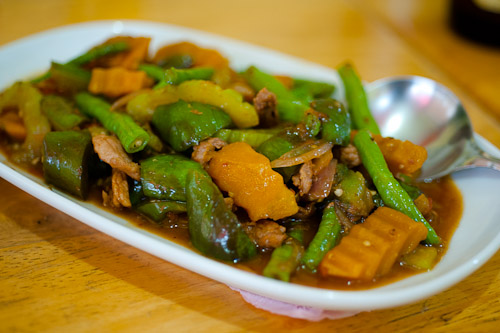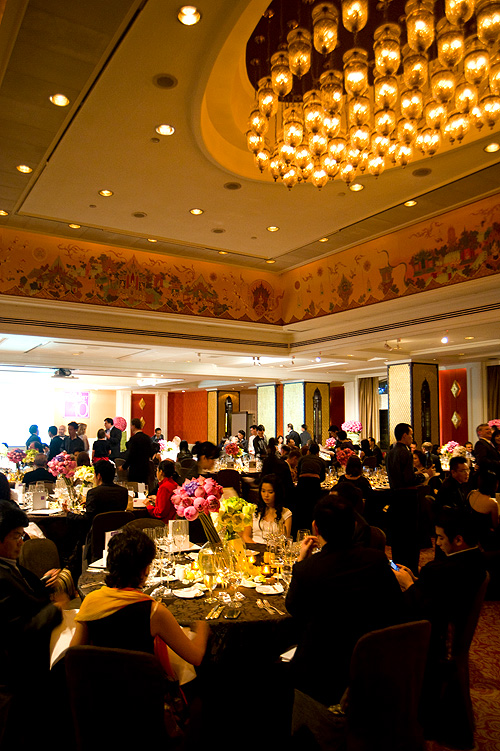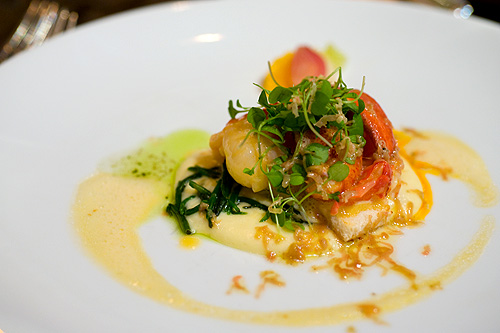 In my previous post I mentioned that I was on a hunt for obscure ethnic restaurants in Bangkok. Well, after a bit of research, I think it's safe to say that it doesn't get much more obscure than my most recent discovery. Amirra is a minuscule, family-run restaurant that serves the food of the African nation of Cameroon.
In my previous post I mentioned that I was on a hunt for obscure ethnic restaurants in Bangkok. Well, after a bit of research, I think it's safe to say that it doesn't get much more obscure than my most recent discovery. Amirra is a minuscule, family-run restaurant that serves the food of the African nation of Cameroon.
I was introduced to the restaurant-- in reality more an open dining room -- by Stanley, a Cameroonian football teammate of my buddy Newley. Arriving in the Nana area one recent afternoon, Stanley led us down a narrow alley, up four flights of stairs and past a very domestic living room to a tiny dining room with three tables. We were greeted by the friendly eponymous owner, and Stanley, speaking rapid French, proceeded to order a virtual West African feast. There was haricots:

a beef and kidney bean stew traditionally eaten with deep-fried or steamed plantains. He explained that this is one of the more common street dishes in Cameroun and apologized for the fact it isn't possible to get "real" plantains in Bangkok, claiming that what we were eating were simply bananas.
There was also gumbo:

stewed okra with chicken, as well as a bowl of légumes, stewed greens with beef, a dish not unlike the US soul food staple collard greens. In fact, Newley, who is from South Carolina, noticed several similarities between these dishes and traditional food of America's south. All the vegetable-based dishes were meant to be taken with couscous de Cameroun, a dish not like the Moroccan-style couscous most of us are familiar with, but rather a variant of fufu, the starchy West African staple. Stanley explained that in Cameroon couscous can be made from any available starch, in particular cassava, but here in Bangkok Amirra has to make do with the next best substitute: cornmeal. Everything was accompanied by a deliciously spicy chili sauce called peppée.
Amirra is not the most sophisticated dining experience in Bangkok, and is a bit of a struggle to find, but for hearty eats and mad street cred, there's no comparison. To get to Amirra from Soi 3, enter the street side street that connects to Soi 3/1, and turn right into the sub-Soi that leads to Masjid Nana. Enter the red door on the right and proceed to the 4th floor.
Amirra 4th fl, directly above the 7-Eleven at the intersection of Soi 3 and Thanon Sukhumvit 089 824 7204 Noon-midnight
View Thai Eats in a larger map












 I'm currently at work on a piece about obscure ethnic restaurants for
I'm currently at work on a piece about obscure ethnic restaurants for 



 When I find myself in an unfamiliar province somewhere in Thailand and am in need of something to eat, my first course of action is typically to call Suthon Sukphisit. Khun Suthon writes the Cornucopia column that runs every Sunday in the Bangkok Post and is a wealth of knowledge about regional Thai food and interesting restaurants. In fact, I think Khun Suthon has been so many restaurants around Thailand that he's beginning to get them mixed up. On a recent trip to Suphanburi, a province about two hours north of Bangkok, I called Khun Suthon to ask if he had any recommendations and without hesitation he replied, "You should go to Paa Muay, it's in Pang Plaa Maa District, just outside Suphanburi." I made a mental note and headed off to Bang Plaa Maa, only to find that there was no Paa Muay, but rather the almost identically-named restaurants Phii Muay, Paa Muay (different tone) and Mae Buay. Not wanting to bother Khun Suthon any more, we placed our bets on Mae Buay, grandest of the lot. And although I haven't yet confirmed it with Khun Suthon, I'm pretty sure we made the right choice.
When I find myself in an unfamiliar province somewhere in Thailand and am in need of something to eat, my first course of action is typically to call Suthon Sukphisit. Khun Suthon writes the Cornucopia column that runs every Sunday in the Bangkok Post and is a wealth of knowledge about regional Thai food and interesting restaurants. In fact, I think Khun Suthon has been so many restaurants around Thailand that he's beginning to get them mixed up. On a recent trip to Suphanburi, a province about two hours north of Bangkok, I called Khun Suthon to ask if he had any recommendations and without hesitation he replied, "You should go to Paa Muay, it's in Pang Plaa Maa District, just outside Suphanburi." I made a mental note and headed off to Bang Plaa Maa, only to find that there was no Paa Muay, but rather the almost identically-named restaurants Phii Muay, Paa Muay (different tone) and Mae Buay. Not wanting to bother Khun Suthon any more, we placed our bets on Mae Buay, grandest of the lot. And although I haven't yet confirmed it with Khun Suthon, I'm pretty sure we made the right choice.


 I was originally drawn to Café Ou Mun, a tiny café in central Macau, for little more than an early morning galão (the Portuguese equivalent of a café au lait) and a pastry. But the quality of the food led me to make a few more visits, including one proper meal.
I was originally drawn to Café Ou Mun, a tiny café in central Macau, for little more than an early morning galão (the Portuguese equivalent of a café au lait) and a pastry. But the quality of the food led me to make a few more visits, including one proper meal.




 Despite my
Despite my 

 Those wishing to taste the true flavours of old Macau can do no better than stop by Riquexó, a restaurant serving Macanese cuisine, a blend of Portuguese, Chinese, and on occasion, Southeast Asian ingredients and cooking styles.
Those wishing to taste the true flavours of old Macau can do no better than stop by Riquexó, a restaurant serving Macanese cuisine, a blend of Portuguese, Chinese, and on occasion, Southeast Asian ingredients and cooking styles.



 Art critic and mate Steven Pettifor has put together
Art critic and mate Steven Pettifor has put together  Despite having owned the place for five centuries, the Portuguese influence on Macau is actually quite superficial. The Macau of today is essentially a very Chinese city with a few Portuguese-style buildings, a very small minority of people of Portuguese descent, a handful of Portuguese restaurants and an abundance of azulejos (Portuguese blue tiles). Fortunately Macau is rather compact, so for those interested, seeking out the remnants of Portuguese culture, particularly those that are edible, is not difficult. And perhaps the most ubiquitous and tastiest remnant of the Portuguese colonial legacy are pastéis de nata, or more commonly in Macau, Portuguese egg tarts.
Despite having owned the place for five centuries, the Portuguese influence on Macau is actually quite superficial. The Macau of today is essentially a very Chinese city with a few Portuguese-style buildings, a very small minority of people of Portuguese descent, a handful of Portuguese restaurants and an abundance of azulejos (Portuguese blue tiles). Fortunately Macau is rather compact, so for those interested, seeking out the remnants of Portuguese culture, particularly those that are edible, is not difficult. And perhaps the most ubiquitous and tastiest remnant of the Portuguese colonial legacy are pastéis de nata, or more commonly in Macau, Portuguese egg tarts.
 I've always liked the idea of dim sum -- countless small Chinese dishes served with an endless flow of green tea (one of my favourite things to drink) sounds wonderful to me -- but I'd yet to encounter a version that I truly enjoyed. My first authentic dim sum meals in Macau and Malaysia were fun, but too meaty and oily for my taste, while much of the dim sum I've come across in Thailand has been processed and flavourless (in addition to being meaty and oily). I thought for sure that I would finally meet my fantasy dim sum in Hong Kong, a city virtually synonymous with the dish, and to a certain extent, I did. In Lin Heung Tea House I found a restaurant that fit my preconceived notion of how a dim sum place should be: a great old hall complete with grumpy waiters, creaking trolleys, old men reading newspapers, lazy ceiling fans and lots of cigarette smoke and tea. But as with previous attempts, I was let down by the food.
I've always liked the idea of dim sum -- countless small Chinese dishes served with an endless flow of green tea (one of my favourite things to drink) sounds wonderful to me -- but I'd yet to encounter a version that I truly enjoyed. My first authentic dim sum meals in Macau and Malaysia were fun, but too meaty and oily for my taste, while much of the dim sum I've come across in Thailand has been processed and flavourless (in addition to being meaty and oily). I thought for sure that I would finally meet my fantasy dim sum in Hong Kong, a city virtually synonymous with the dish, and to a certain extent, I did. In Lin Heung Tea House I found a restaurant that fit my preconceived notion of how a dim sum place should be: a great old hall complete with grumpy waiters, creaking trolleys, old men reading newspapers, lazy ceiling fans and lots of cigarette smoke and tea. But as with previous attempts, I was let down by the food.
 In 2008 the Michelin guide expanded its borders to include Hong Kong and Macau. This gained quite a bit of attention in the international media, as the influential guide had previously limited itself to fine dining in Western countries. This apparently also generated a great deal of interest in Hong Kong, as in an effort to promote the accomplishment, I was taken to two Michelin-starred restaurants on my recent press trip there. Of these, the restaurant that stands out the most in my mind is Yung Kee, a nearly 60 year-old Hong Kong staple and recent recipient of a single Michelin star.
In 2008 the Michelin guide expanded its borders to include Hong Kong and Macau. This gained quite a bit of attention in the international media, as the influential guide had previously limited itself to fine dining in Western countries. This apparently also generated a great deal of interest in Hong Kong, as in an effort to promote the accomplishment, I was taken to two Michelin-starred restaurants on my recent press trip there. Of these, the restaurant that stands out the most in my mind is Yung Kee, a nearly 60 year-old Hong Kong staple and recent recipient of a single Michelin star.




 While in Hong Kong I got the chance to eat at some Michelin-starred restaurants (one of which I'll blog on soon) and a few other similarly upscale places, but to be honest, what I really wanted to do was eat what regular Hong Kong people eat. I finally got my chance at Nathan Congee and Noodle, a closet-sized restaurant in Kowloon.
While in Hong Kong I got the chance to eat at some Michelin-starred restaurants (one of which I'll blog on soon) and a few other similarly upscale places, but to be honest, what I really wanted to do was eat what regular Hong Kong people eat. I finally got my chance at Nathan Congee and Noodle, a closet-sized restaurant in Kowloon.




 Chefs at work in the kitchen of the InterContinental Hong Kong's Chinese restaurant
Chefs at work in the kitchen of the InterContinental Hong Kong's Chinese restaurant I'm a bit late on relaying this, but Thailand's annual Jay or vegetarian festival is currently is full swing. I've made a couple trips to Bangkok's Chinatown, the centre of activity, and I can report with confidence that the offerings are as vegetable-free and oily as ever:
I'm a bit late on relaying this, but Thailand's annual Jay or vegetarian festival is currently is full swing. I've made a couple trips to Bangkok's Chinatown, the centre of activity, and I can report with confidence that the offerings are as vegetable-free and oily as ever:
 Phai Kiaw ('Green Bamboo') is, as far as I'm aware, the only place in Bangkok where one can get Sichuan-style hot pot. It's not as delicious as the huo guo I've encountered in China, but is a fair approximation, and a welcome change from
Phai Kiaw ('Green Bamboo') is, as far as I'm aware, the only place in Bangkok where one can get Sichuan-style hot pot. It's not as delicious as the huo guo I've encountered in China, but is a fair approximation, and a welcome change from 

 Piang Kee is both the most noteworthy and quirkiest restaurant I've come across in Bangkok in a long while. For starters, the Chinatown-based restaurant specialises in
Piang Kee is both the most noteworthy and quirkiest restaurant I've come across in Bangkok in a long while. For starters, the Chinatown-based restaurant specialises in 










 Chef Fulvio Siccardi shaving truffles at the Four Seasons Bangkok World Gourmet Festival
Chef Fulvio Siccardi shaving truffles at the Four Seasons Bangkok World Gourmet Festival
 Chef Fulvio Siccardi's Lightly smoked marinated beef tenderloin with grain mustard and chives emulsion
Chef Fulvio Siccardi's Lightly smoked marinated beef tenderloin with grain mustard and chives emulsion Chef Fulvio Siccardi's Egg in jail
Chef Fulvio Siccardi's Egg in jail Egg in jail
Egg in jail Chef Fulvio Siccardi's Potato gnocchi with bra sausage and veal ragu
Chef Fulvio Siccardi's Potato gnocchi with bra sausage and veal ragu Chef Fulvio Siccardi's Carmelized vinegar goose leg with Belgium endive and chanterelle mushroom
Chef Fulvio Siccardi's Carmelized vinegar goose leg with Belgium endive and chanterelle mushroom Chef Fulvio Siccardi's Panna cotta trilogy
Chef Fulvio Siccardi's Panna cotta trilogy At the Four Seasons Bangkok World Gourmet Festival's Gala Dinner
At the Four Seasons Bangkok World Gourmet Festival's Gala Dinner Chef Christine Manfield's Woodbridge smoked ocean trout, tea smoked oysters, blood sausage, celeriac and apple salad
Chef Christine Manfield's Woodbridge smoked ocean trout, tea smoked oysters, blood sausage, celeriac and apple salad Michael Ginor's Citrus butter poached lobster with sea beans and potato cream
Michael Ginor's Citrus butter poached lobster with sea beans and potato cream Chef David Kinch providing a foie gras garnish at the Four Seasons Bangkok World Gourmet Festival's Gala Dinner
Chef David Kinch providing a foie gras garnish at the Four Seasons Bangkok World Gourmet Festival's Gala Dinner Inside the kitchen at the Four Seasons Bangkok World Gourmet Festival's Gala Dinner
Inside the kitchen at the Four Seasons Bangkok World Gourmet Festival's Gala Dinner Dinner service at the Four Seasons Bangkok World Gourmet Festival's Gala Dinner
Dinner service at the Four Seasons Bangkok World Gourmet Festival's Gala Dinner Chef Francois Payard's Palet d'or with hot and cold chocolate
Chef Francois Payard's Palet d'or with hot and cold chocolate